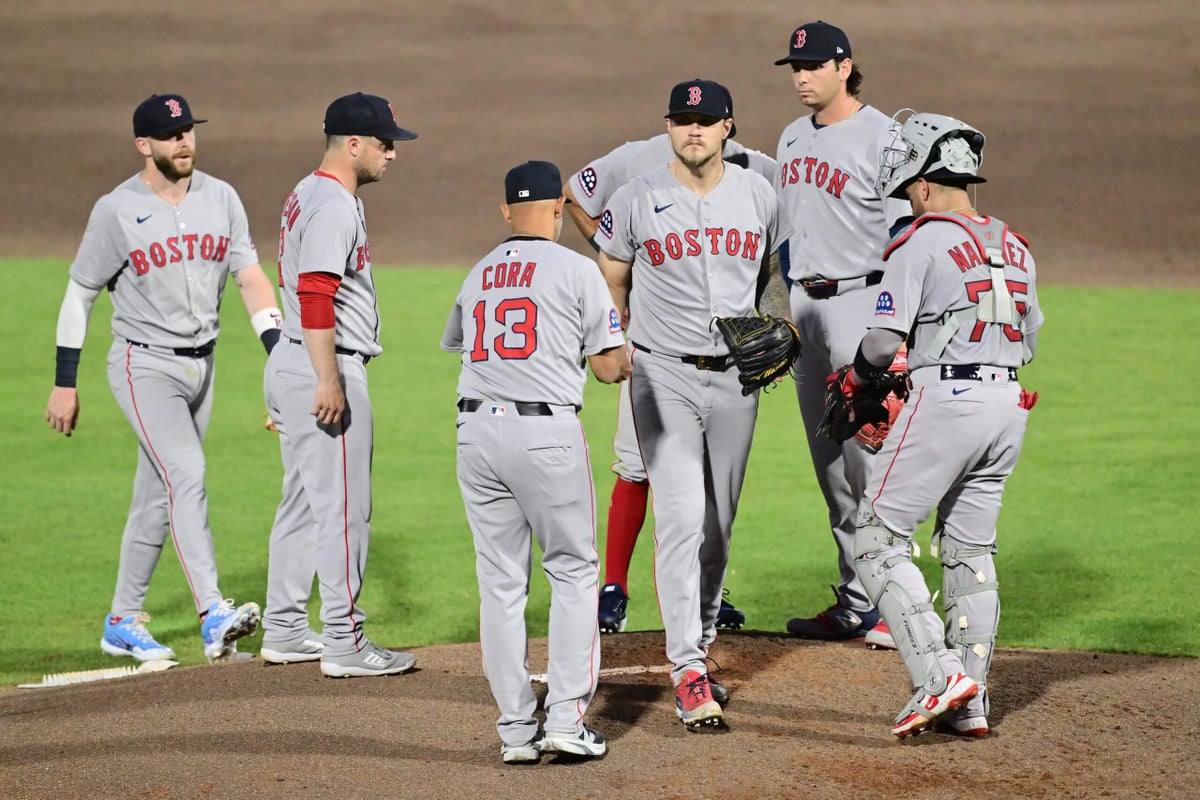This column is going to focus on Tanner Houck, who is having a rough start to this season. We’ll explore what he is doing differently and some possibilities for how he can get back on track.
Houck is an interesting case because he has such a strong pitch mix and high potential. But through 24.2 innings (including Sunday’s start, which I’ll have more on below), Houck has a 6.20 FIP, 10% walk rate, and 16.4% strikeout rate. To understand what’s going on, let’s start by looking at his three primary pitches:
- Sinker (94 mph): Plus sink and above average run. Used vs. both hands.
- Sweeper (83 mph): Plus sweep and above average depth. Used vs. both hands.
- Splitter (88 mph): Plus depth. Used vs. lefties, rare usage vs. righties.
Houck features a strong pitch mix with three above-average offerings. He also throws a four-seamer and previously threw a cutter, but we will get into that later. Digging deeper, I believe Houck needs to address two major issues before achieving the same success as last season.
Issue 1: Pitch mix vs. lefties
Historically, his biggest weakness is facing lefties. There is a major discrepancy in results when looking at his career splits:
| Career | K% | BB% | FIP |
|---|---|---|---|
|
Vs LHH |
20% |
10% |
4.45 |
|
Vs RHH |
25% |
6% |
2.83 |
In 2023, Houck introduced a cutter as an additional weapon against lefties. I really liked this idea (and still do) because it provided him a pitch to use against left-handed batters. Looking at the heat map below, he located it well, up and in against lefties.

The cutter performed well that season, with a .378 xSLG (best opponent xSLG of his pitches) and a 27% 2K conversion rate. He used it as his primary fastball against lefties, throwing it 19% of the time.
Despite the success of the cutter, Houck significantly limited its usage in 2024, throwing it only 3% of the time against lefties, and in 2025, he has eliminated it altogether. Instead, he’s reintroduced a four-seamer to his pitch mix.
| Vs LHH | 2023 | 2024 | 2025 |
|---|---|---|---|
|
Splitter |
18% |
39% |
36% |
|
Sweeper |
32% * |
37% |
33% |
|
Sinker |
15% |
22% |
22% |
|
Cutter |
19% |
3% |
0% |
|
Fourseam |
15% |
0% |
10% |
* In 2023, Houck’s slider was more of a gyro-slider than a sweeper.
There are three issues with the four-seamer:
- He isn’t landing it for strikes.
- It doesn’t run in on lefties like a cutter does.
- It doesn’t match his arm slot.
In terms of control, the four-seamer is consistently ending up above the zone.
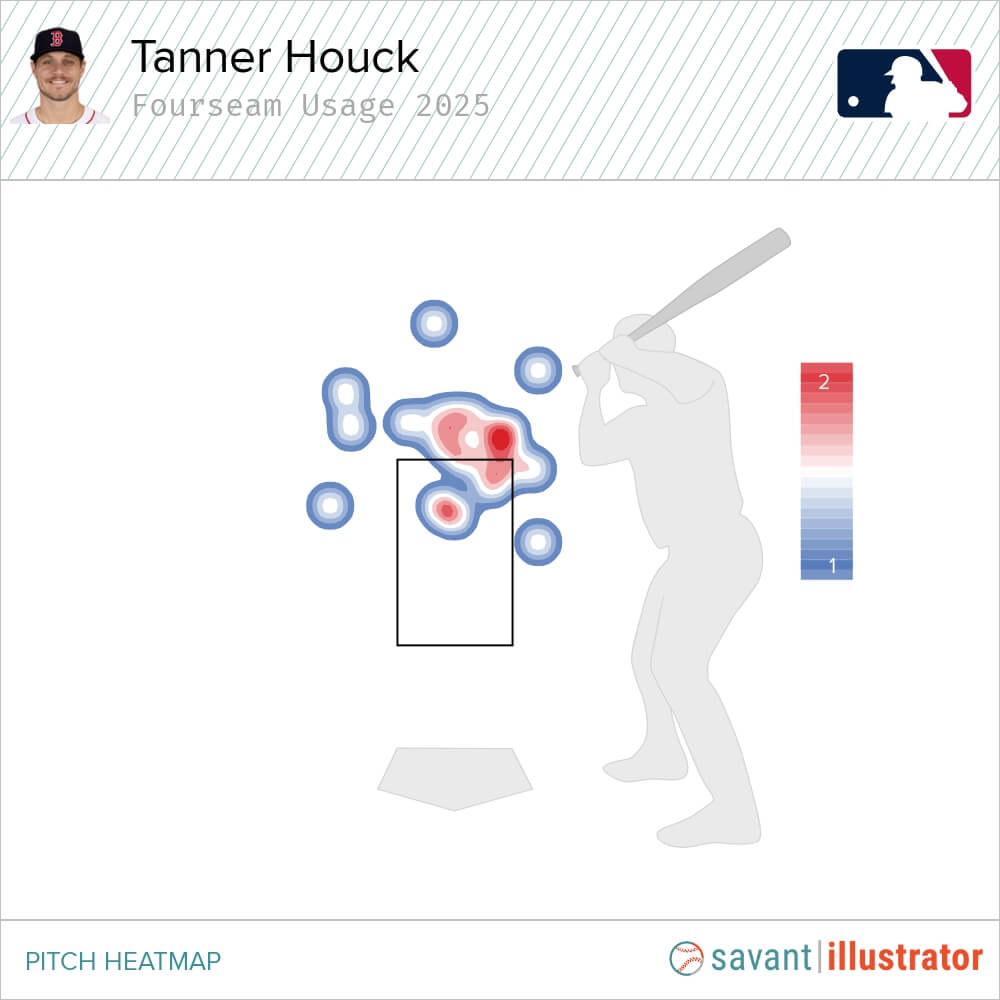
This signals to me he is trying to use the four-seamer as a chase pitch when he is ahead in the count. However, of the 18 four-seamers he’s thrown against lefties so far, he’s only gotten one swing and miss. If hitters see a hard pitch up and in, they can let it go.
In terms of movement, a four-seamer is going to run arm-side away from a lefty. The intriguing quality of a cutter is that it moves glove-side in on a lefty, jamming them.
Advertisement
Finally, Houck has a low three-quarters arm slot, almost sidearm. For pitchers with a slot like Houck, generally speaking, an east-west pitch profile is common. It is a lot harder for Houck to generate even average movement for a rising four-seamer from that slot. It’s easier to generate horizontal movement like sweep, run, and cut based on the natural movement a pitcher will get from that slot.
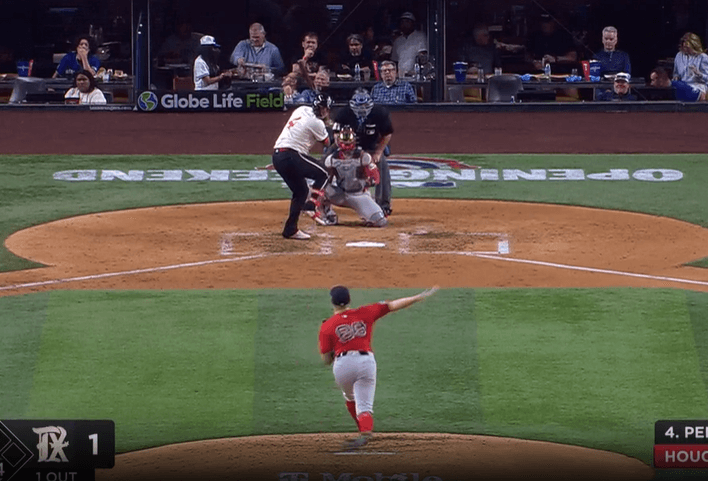
Based on data so far, Houck’s four-seamer has almost 6 inches less vertical movement compared to four-seamers with similar velocity.
The reason he is throwing a four-seamer is because the sinker results in a lot of damage against lefties. The confusing part is how he is using the four-seamer. If he is going to use the four-seamer at all, he should be using it for strikes. Or, ditch the four-seamer and bring back the cutter, which already has a proven track record of success.
The swap of the cutter with the four-seamer is also leading to issues with results, which relate to the second major issue: game planning.
Issue 2: Game planning vs. both hands
Houck has great stuff, and he also does a great job of getting ahead. His 63% first pitch strike rate is consistent with his career and remains above the MLB average. And yet, his strikeout rate is only 13%, and his ground ball rate is at its lowest since 2021. This leads me to believe Houck’s game planning could use some changes.
If I’m an opposing team, I’m stockpiling left-handed hitters to put in the lineup when Houck is pitching.
Between eliminating the cutter and inability to throw the four-seamer for strikes, lefties can just look out over the plate and wait. As shown in the heat map below, the sweeper and sinker consistently end up in the middle or outer third.

And looking at where Houck has given up hits so far, this lines up:
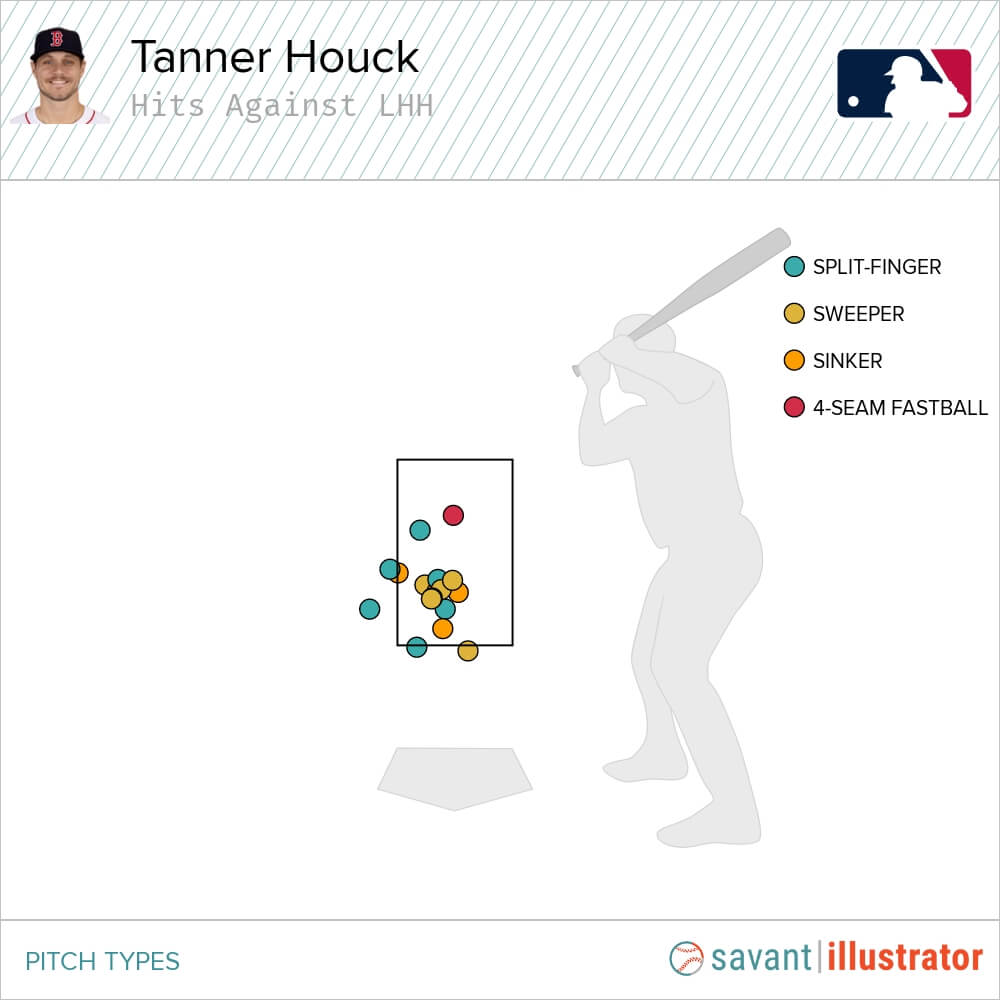
The splitter is a plus pitch. But because he will throw the sweeper and sinker, hitters don’t need to swing at the splitter. Houck is throwing it as a chase pitch, but there is no need to chase when you can expect a pitch out over the plate.
The first change I’ll propose is that Houck should try throwing the splitter more frequently and for strikes at the bottom of the zone. It can and should be more than a chase pitch. Compared to the sweeper and sinker, the splitter is the most platoon-neutral pitch.
Advertisement
Due to the nature of the splitter, if hitters are not whiffing at it, it should at least generate ground balls. Additionally, it would force lefties to pay attention to a plus pitch at the bottom of the zone.
By raising the usage of the splitter, he can then reduce the usage of the sinker and sweeper. Ideally, the sinker usage could drop dramatically to rare usage. He could use it front door against lefties to keep them looking for something else.
Then, if he is going to continue throwing the four-seamer, he needs to be able to throw it for strikes at the top of the zone. That being said, ideally, he would go back to his cutter and use it in, on the hands.
Mixing things up and becoming more unpredictable will also help the sweeper play better. He should be using the sweeper either back door, or back foot, when there are two strikes or he is ahead in the count. He needs to stop landing it middle and get it down.
Overall, if he sticks with his current pitch mix, he needs to become way less predictable.
Against righties, Houck throws his sinker and sweeper most frequently, and rarely throws his splitter and four-seamer.
| Vs RHH | 2024 | 2025 |
|---|---|---|
|
Sinker |
44% |
49% |
|
Sweeper |
46% |
42% |
|
Splitter |
10% |
7% |
|
Fourseam |
0% |
3% |
The sinker and sweeper combination is a common one, and last season, Houck did a great job of throwing the sinker in on righties, sweeper away, and mixed the splitter in and lower/outer edge.

This season, however, Houck is throwing the sinker middle and is not landing the sweeper for strikes.
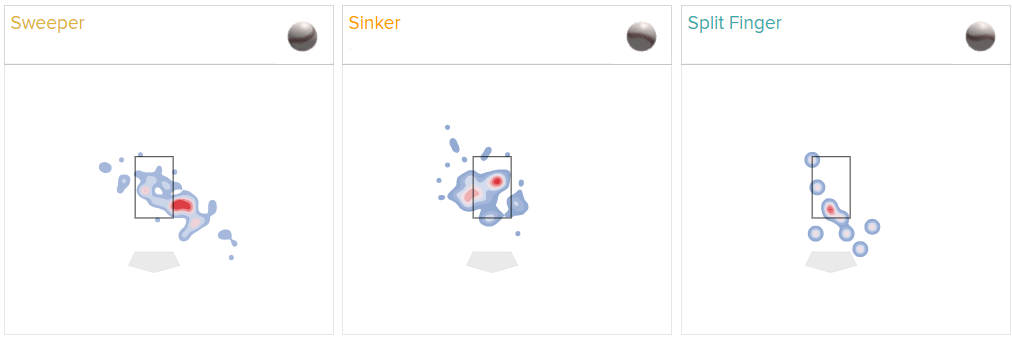
As a result, the sinker has a .688 xSLG. This signals a lack of command. Houck needs to locate the pitch better for it to be effective.
Houck is also throwing his sinker more than his sweeper against righties this season. In 2024, he leaned on his sweeper as his primary pitch over the sinker. This made sense because, in terms of results, his sinker performed the worst of his three pitches in 2024 with a .448 xSLG vs. righties.
Advertisement
Looking at why he would then start throwing the sinker more, my assumption is that while Houck is getting ahead, he is having trouble getting to two strikes. Therefore, he is in more situations where he needs to throw a strike. The sinker is easier than the sweeper to land in the zone, and as a result, he is likely more comfortable throwing it when he needs a strike.
Meanwhile, the sweeper has 2 inches less sweep than last season, but it is still an above-average pitch. The results against remain strong — .265 xSLG and a 36% whiff rate. While he has been going to the sinker more, the sweeper has stayed Houck’s go-to in counts with two strikes.
I’d like to see Houck reduce the sinker usage in favor of the sweeper and the splitter, which he has very rarely used against righties this season. His splitter has great results. It was tied for third in the majors last season with an elite run value of 12 vs. both hands.
Overall, this is a very frustrating situation, as Houck possesses the talent and potential to be a top-tier pitcher who can generate both strikeouts and ground balls. I still believe he can get back on track and be an above-average starter. Looking at fantasy, starting Houck is risky, especially if he is facing a lefty-heavy lineup. And opposing teams will (and are already) taking advantage of his struggles getting lefties out. Against righties, it comes down to commanding his sinker and throwing it to the right locations. Overall, when he gets ahead, he needs to stay ahead, as a lack of command is affecting his pitch selection. But, Houck has all of the tools to get outs against both hands consistently. With the right game plan, he can get back on track.
Update following Sunday’s start: Houck had a successful outing, pitching six innings against the White Sox and finishing with 2 ER, 7 K, and 2 BB. He started a bit rocky, battling in almost every at-bat and then giving up a two-run home run to Matt Thaiss on a four-seamer up (see notes on four-seamer usage above). In the third inning, he started to settle in and ultimately finished strong with a quality start. While this success occurred against one of the weakest offensive teams in baseball, Houck still deserves credit for his performance. Still, my thoughts on Houck moving forward remain the same. On a positive note, the pitch mix in Sunday’s start was slightly better than we’ve seen — he was mixing in the splitter more against lefties, while reducing the usage of his sinker and four-seamer. We’ll see if this trend continues in his next couple of starts.
Miscellaneous Notes
► San Francisco’s Jung Hoo Lee (OF) is off to a hot start with an incredible 1.055 OPS through 18 games. A BABIP of .382 might indicate that some regression is coming; however, he has also made some intentional changes that are contributing to his success.
He’s ambushing first pitches 10% more than last season, signaling a change in approach, and he’s recognizing pitches better — he is swinging at pitches in the zone 6% more frequently and is walking more. While his more aggressive approach has led to more swings and misses, his strikeout rate remains significantly better than average at only 16%, and his in-zone miss rate is an elite 7%.
Advertisement
While his swing is not that of a power hitter, Lee is capable of getting extra base hits with an all-fields approach. In MLB (particularly at Oracle Park), his launch angle plus his speed can translate to a lot of doubles. And Lee is currently leading the NL with 10 doubles on the year.
► St. Louis’ Victor Scott (OF) made some mechanical adjustments and changes to his approach. The video below walks through some of the mechanical changes he’s made.
Breaking down Victor Scott’s mechanical changes: pic.twitter.com/PumHIWON9k
— Andrea (@scoutgirlreport) April 4, 2025
The goal of these changes is to improve his contact rates. So far, his bat-to-ball stats are similar to last season, though his strikeout and ground-ball rates are improved. He’s also been making better swing decisions. Scott is showing a more patient approach to first pitches and is swinging at offerings in the zone 7% more than last season. He is also chasing 5% less. As a result, his walk rate is 7% better and is now above average. In fact, through only 20 games this season, Scott already has more walks than he did in 53 games in 2024.
Amidst these adjustments, his biggest strength remains his speed right now. There is some upside if he can remain consistent with the mechanical changes and continue making contact regularly.
► With a 1.095 OPS through 19 games, Tyler Soderstrom (1B) is breaking out to start the season. Although he may experience some regression, there are indications that this type of success will continue.
The biggest improvement is coming in his quality of contact. Soderstrom did well against fastballs last season but struggled against breaking and off-speed stuff. This season, he is performing well across the board, with his lowest xSLG being .446 against off-speed pitches. This improvement against off-speed and breaking pitches is a signal that things are clicking in his approach and mechanics.
His barrel and hard-hit rates are both elite at 21% and 53%, respectively. Through Sunday, he is tied with Cal Raleigh for the MLB lead with 9 HR. His contact skills are also improved, as his zone contact rate and whiff rate are both better than average. While I don’t expect him to maintain this unprecedented pace for the entire season, there are many signs indicating that Soderstrom will have a strong offensive season.
(Top photo of Tanner Houck, Boston Red Sox players: Julio Aguilar / Getty Images)
